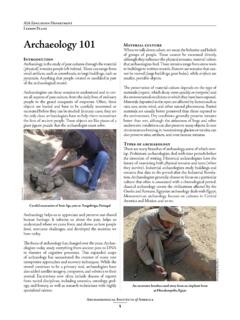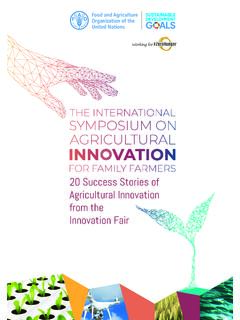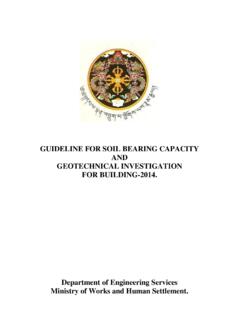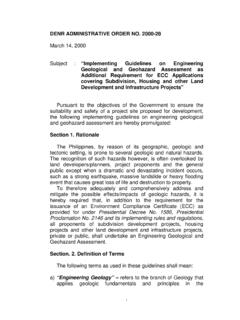Transcription of ENVIRONMENTAL MANAGEMENT IN ETHIOPIA
1 ENVIRONMENTAL MANAGEMENT IN ETHIOPIA : Have the National Conservation Plans Worked? . - ENVIRONMENTAL Forum Publications Series No. 1 Shibru Tedla and Kifle Lemma Organization for Social Science Research in Eastern and Southern Africa (OSSREA) ENVIRONMENTAL MANAGEMENT IN ETHIOPIA Have the National Conservation plans worlzed? Orgauization for Social Science Research ill Eastern ::Ind Southern AlriC:l (OSSREA) Addis Ababa, ETHIOPIA Td: 151-1-551163/119705 Fax: 251 } 551399 E mail: ENVIRONMENTAL Forum Publications Series Shibru Tedla::-and Kifle Lemma::-::--October 1998 * Manager of Eco-consult; an environment and development concern and fomleriy Professor of Biology at Addis Ababa University * * Director of Conservation Strategy of ETHIOPIA OSSREA acknowledges the support of Swedish International Development Cooperation Agency (Sida/SAREC) and Norwegian Agency for Development Cooperation (NORAD) for this project.
2 OSSREA 1998 Addis Ababa, EththlOpia Text layouts: Eta/elll Ellgeda Organization for Social Science Research in Eastern and Southern Ali-ica (OSSREA) TABLE OF CONTENTS 1. INTRODUCTION 1 Brief Description of the Natural Environment of the Country 1 The Need for the Present Study 2 2. BACKGROUND 3 Global Overview 3 ENVIRONMENTAL Initiatives at the Regional (Africa) Level 5 Major ENVIRONMENTAL Concerns at the National Level ( ETHIOPIA ) 7 3. ETHIOPIA 'S NATIONAL CONSERVATION PLANS 13 Evolution of Conservation Policies and Legislation 13 The Post-1991 Period (After the Derg) 24 The Legal Framework: A Bird's Eye-view of the Process 30 4. MAJOR ENVIRONMENTAL ACTORS AND THEIR MANDATE 32 The Central/Federal Level Organs of Government The Regional Governments' Organs 32 37 5 . WHY HAVEN'T THE CONSERVATION PLANS/ POLICIES WORKED? 38 Responses to Government Policies 38 5.
3 2 Inherent Problems in Policies, Laws and Regulations, and Implementing Mechanisms 46 6 . FUTURE PROSPECTS Constitution Sectoral Legislation 50 50 51 Institutional Legislation 52 7. CONCLUSION AND RECOMMENDATIONS 53 Conclusions 53 Recommendations 55 ENVIRONMENTAL Laws 55 The Fifth Country Program and ENVIRONMENTAL Measures Recommended in its Implementation 57 Recommendations on the overall programme 60 Bibliography 62 Annexes 64 1. INTRODUCTION Brief Description of the Natural Environment of the Country ENVIRONMENTAL Baseline Data Eth~opia, situated in the Hom of Africa, has a total land area of million Km-. Its population is estimated at 58 million with a dfnsity of more than 90 persons per Km' in the highlands and 10 persons per Km in the lowlands. Land Ecosystem The main physical feature of the country is the diversity in altitude and accompanying climatic and ecological variations.
4 The altitude ranges from 120 meters below to 4500 above sea level. The climate in the highlands (areas more than 1800 masl) is mild and the annual precipitation ranges from 800 to over 2200 mm. The lowlands are hot with annual rainfall varying from less than 200 mm to 800 mm. Of the total area 60 percent is reported to be suitable for agricultural purposes. The natural forest cover is percent of the total area. Water Ecosystem ETHIOPIA has a large water resources potential which includes eleven major , lakes with a total area of 7,400 Km , IWelve river basins with a total annual surface runoff of about ]10 billion m and ground water with an estimated capacity billion m . Most of the rivers are transboundary with more than 75% of the annual surface run-off draining to neighbouring countries. The water resources provide large potential for hydro-power generation, irrigation and fisheries.
5 Mineral resources such as soda ash are also extracted from lake brine. Water quality in urban areas is poor due to pollution from domestic and industrial wastes. Main Non-renewable Resources The main non-renewable reso urces, even though limited, are minerals of which gold, rare minerals like potash, platinum, marble, phosphates, high quality coal, shale oil and iron are imp0l1ant. Natural gas and hydrothermal potential are also substantial. Biological Diversity and Renewable Resources ETHIOPIA has a varied ecological setting, which has facilitated thc evolution of various forms oflifc. As a rcsult, ETHIOPIA is one of the twelve Vavilov ce ntres 2 ENVIRONMENTAL MANAGEMENT ill ETHIOPIA of primary plant domestication in the world. It has a very high genetic diversity in four of the world's widely grown food crops (wheat, barley, sorghum, peas), in three of the world's most important industrial crops (linseed, castor, and cotton), in the world's most important cash crop (coffee), in food crops of regional or local importance (teff, finger millet, etc.)
6 And in forage plants of world importance (clovers, oats, etc.). ETHIOPIA has also a high level of endemicity in its wild flora and fauna (NCSS, 1 994a). Agriculture is the main economic activity, accounting for 45% of the GDP. The main products are teff, sorghum, barely, field peas, chick peas, niger seed, linseed, enset, cotton and coffee. Small-holder fallning is predominant, accounting for more than 90% of agricultural area and 95% of total area under crop. The Need for the Present Study ETHIOPIA is a country where natural resource degradation has been going on for centuries. At the present time it is facing a serious ecological imbalance triggered mainly by the fast increment of its population size. This has led to a destructive cycle of land use pattern, involving deforestation followed by continuous cropping and graz ing with little or no investment on the soil.
7 This pattern leaves few opportunities for the natural vegetation to regeneratc, making the land more susceptible to erosion, affecting the hydrological cycle and altering the regimes of the rivers. Changing this situation calls for better MANAGEMENT of the natural resources including putting appropriate policies and regulations in (, lace to facilitate better ENVIRONMENTAL MANAGEMENT . There is a need to appreciate the state of ENVIRONMENTAL MANAGEMENT (mismanagement) in ETHIOPIA . This could be addressed through an in depth study of ENVIRONMENTAL MANAGEMENT arrangements, in terms of existing institutions, laws and regulations that have impact on the environment as well as of policies and spec ific strategies fornlUlated for the MANAGEMENT of the environment. It is after the appreciation of the situation that gaps could be identified and subsequently addressed for the enhancement of ENVIRONMENTAL MANAGEMENT capacity.)
8 The main objective of the present study is, therefore, to see whether or not the conservation plans in ETHIOPIA have worked, and if not, to find out why they have not worked, by assessing the prevailing situation in ENVIRONMENTAL MANAGEMENT and by identifying missing links in proper ENVIRONMENTAL MANAGEMENT . The study will facilitate identification of issues for further study. Ellvirollmellfal Forum Series No. J 3 2. BACKGROUND Global Overview Relatively speaking the importance of natural resources MANAGEMENT has acquired recognition only recently. Human kind has been using natural resources since his emergence as Homo sapiens. The impact of human activity on the natural resources surrounding human kind was initially insignificant or zero. Such impact became more and more conspicuous as the population expanded and also as new capacity and skill to manipulate natural processes increased.
9 Throughout the millennia, human knowledge and technology have grown in leaps and bounds. Such growth, although slow initially (eg. change from Stone Age to the [ron Age), had quickened as time passed, the gaps in technological change (revolution) becoming shorter and shorter, and the rate of knowledge and skills acquisition growing faster and faster, respectively. Despite this vast accumulation of knowledge and skills, it is only recently that a simple truth has become obvious, and that is: unless natural resources of planet Earth are used sustainably, the continued survival of human kind on earth will be at stake. There is no point in arguing about the reaso ns why it has taken so long for this truth to see the light of day. Whatever the reason for delays in response, there is now an urgent need to address ENVIRONMENTAL MANAGEMENT . What we have today is a world divided, roughly, into developed and developing.]
10 The developed part, comprising about 20% of the world's population is sustaining its life style by using 80% of the total re sources utilised whereas the developing world, consisting of 80% of the world's population, consumes roughly only 20% of the same. Excessive consumption in the developed world is leading to very fast depletions in both renewable and non-renewable resources. Industrial and related pollution is a disease in the developed countries, causing air, water, and land pollution, poisoning these resources so much that their life support capacity is drastically diminishing. These facts are not reflected in the indicators we use to measure human well being such as education, health, shelter, among others. If they had been, thc results would not have looked so good. When we look at the developing countries, however, what we find is that there is a lack of well being both for humans and in the eco-system, and the situation is continuously getting worse.










